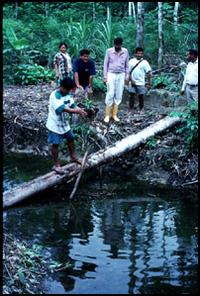
Local group helps in EcuadorRelated story: Judge to decide Ecuador case
By STEVE PFARRER, Staff Writer Saturday, June26, 1999 -- (AMHERST) - In the last decade, a disturbing image has emerged from the great rain forests of South America - that of environmental devastation brought by rampant mining, oil drilling and the clear-cutting of trees, and with it the bewilderment of indigenous people driven from or living in squalor in their ruined lands. But in a small office in Hampshire College, a move is in progress to help preserve the homes and way of life of two small groups of native people in a remote corner of Ecuador, where oil exploration has dramatically altered the landscape. For more than 2 1/2 years, the Institute for Science and Interdisciplinary Studies at Hampshire has been working with the Secoya of Ecuador on several fronts: helping natives develop aquaculture, or fish farming, methods to produce more food; providing health assistance and education; and helping villagers understand the environmental and technical aspects of the development unfolding around them. "We're trying to give the Secoya the tools they need for dealing with a radically changing environment," said James Oldham, the ISIS director of what's known as the Secoya Survival Project. "They're negotiating with huge oil companies whose operations have an enormous impact on their day-to-day lives." ISIS, based at Hampshire, is both an independent nonprofit organization and part of Hampshire's School of Natural Science. It has a regular staff of about seven, not including consultants and student interns, and a separate board of directors whose members represent a number of colleges and organizations. Started in 1992 by Hampshire physics Professor Herbert Bernstein, who is now the organization's president, ISIS operates on the premise that scientists need to form closer connections with ordinary citizens and communities to understand how advances in technology are affecting society. ISIS has been working with the Secoya people, who number about 450 in Ecuador, since early 1997, said Oldham, a Hampshire graduate who spends about one-third of his time in Ecuador each year, making several trips to the region. More recently, the organization has also begun working with the Siona, another indigenous group in the region. Oldham stresses that ISIS is there to help and not run the lives of the native peoples. Referring to the aquaculture project, in which natives have built small dams on rivers and streams to form pools for raising fish, he said "It's their project - we give them some of the materials and support, and they take it from there." Sonia Lindop, the Secoya project coordinator, who also travels frequently to the area, added "The ponds are very popular - they're prompting other villagers to make them as well." Inspirational visit The Secoya project traces its origins to a visit one of the tribe's leaders, Elias Piyahuaje Payahuaje, made to this area in 1992, when he was a delegate to the Institute of Training and Development, a nonprofit group in Amherst that teaches leadership skills to groups from developing nations around the world. Payahuaje's accounts of how oil development in Ecuador was destroying his people's lives prompted the formation of a local group, the Friends of the Amazon Secoya, and grants ISIS and that group received in 1995 brought Payahuaje back to Amherst in 1995 for further talks on the impact of oil development on the Secoya. ISIS, with grant funding it received, began developing its aid plan in 1996, and Oldham said the agency has worked with the Ecuadorian Secoya since 1997. The problems are manifold: Oil spills have polluted waterways throughout the region, killing fish and sickening people, while roads built by oil companies have brought settlers in their wake, who have cleared large areas of forest and killed and driven off game that native people have traditionally depended on for food. The environmental damage is the subject of a pending lawsuit filed by an Amherst lawyer, Cristobal Bonifaz, against Texaco Inc. on behalf of 30,000 Ecuadoreans, including the Secoya (see related article). Oldham adds that, aside from the physical damage it has brought to their environment, oil drilling has disrupted the communal life of the Secoya. Individual families are now scrambling to build fish ponds to produce more food for themselves, he said, while the reduced forest acreage means there's more competition between people for game. "Life is becoming much more individual-based," he said. He notes that the Secoya are now negotiating with the Occidental Corp., which has leased land from the Ecuadorean government to drill for oil. Oldham said Secoya leaders are discussing with Occidental ways the company can minimize its impact, but that the negotiations are complicated by conflicting Ecuadorean laws, divisions within the Secoya themselves, and cultural misunderstandings. The job of ISIS, said Lindop, is to "help translate all the technical information" so that the Secoya can make informed decisions on how their lives will be affected by new oil drilling. Lindop, for example, suggests that oil companies can minimize their impact by using helicopters, rather than building roads, to bring equipment to a drilling site. Oldham says about two-thirds of the Secoya have become involved in aquaculture, and he points to further efforts ISIS has developed, along with Ecuadorean consultants, to help the group: protecting drinking water supplies; raising new crops; training Secoyans to do a video documentary project of their culture; and convening an environmental study team that will measure the impact of oil drilling. Oldham adds that ISIS's budget for the project, which began at $30,000, is now approaching $100,000, thanks to grants from several organizations - including some in the Pioneer Valley - and dogged fund-raising. "This is a long-term project for us," he said. "We're very committed to it."
|
© Copyright 1999. All rights reserved.

